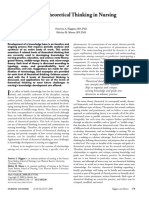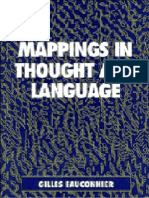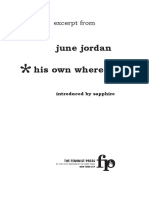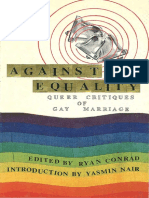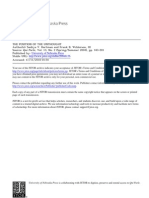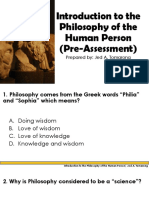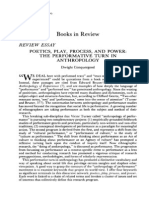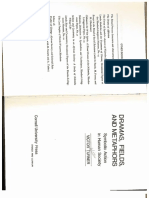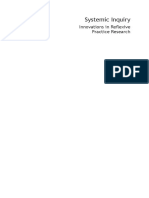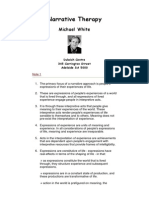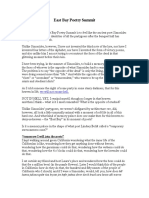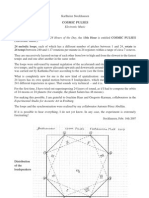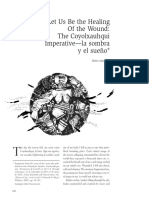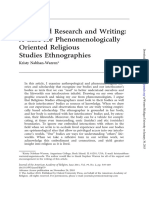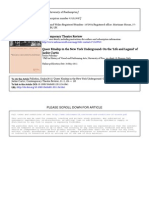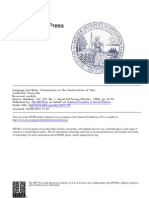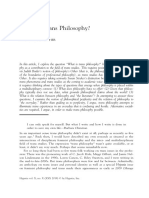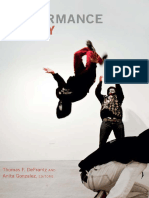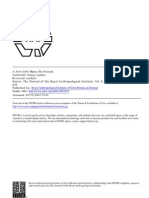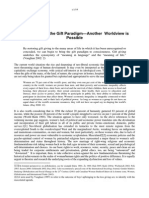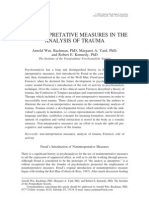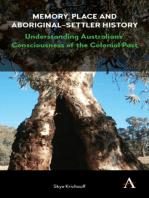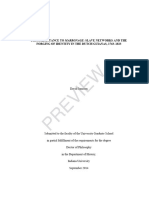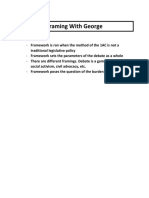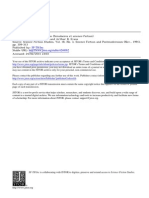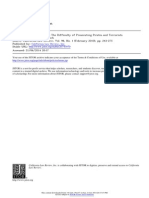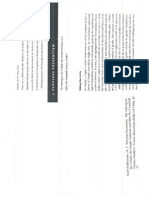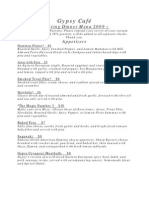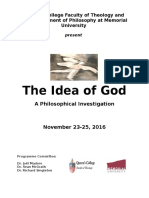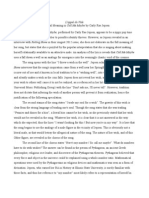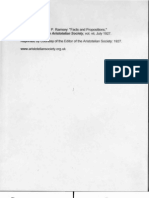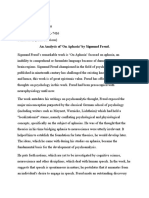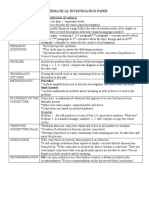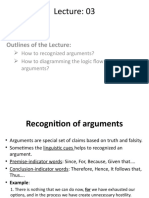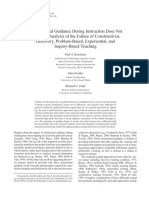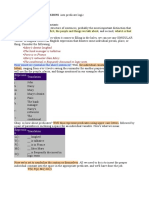Da Silva - 1 Life 0 Blackness - Matter Beyond The Equation of Value
Da Silva - 1 Life 0 Blackness - Matter Beyond The Equation of Value
Uploaded by
docbrown85Copyright:
Available Formats
Da Silva - 1 Life 0 Blackness - Matter Beyond The Equation of Value
Da Silva - 1 Life 0 Blackness - Matter Beyond The Equation of Value
Uploaded by
docbrown85Original Title
Copyright
Available Formats
Share this document
Did you find this document useful?
Is this content inappropriate?
Copyright:
Available Formats
Da Silva - 1 Life 0 Blackness - Matter Beyond The Equation of Value
Da Silva - 1 Life 0 Blackness - Matter Beyond The Equation of Value
Uploaded by
docbrown85Copyright:
Available Formats
1.
A thing, affair, concern
2. That which constitutes or forms the
basis of thought, speech, or action
3. In purely physical application
4. The substance, or substances
01/11
collectively, of which something consists;
constituent material, esp. of a particular
kind. [rare]
Contrasted with form:
22. Philos.
a) In Aristotelian and scholastic philosophy:
that component of a thing which has bare
existence but requires an essential
determinant (form) to make it a thing of a
Denise Ferreira da Silva determinate kind.
b) In scholastic philosophy: the result of the
1 (life) Ö 0 first act of creation, i.e. substance without
form. Obs
c) In Kantian philosophy: the element in
(blackness) = ° knowledge supplied by or derived from
sensation, as distinct from that which is
− ° or ° / °: On contributed a priori by the mind (the forms
of intuition and the categories of the
understanding).1
Matter Beyond
What if blackness referred to rare and obsolete
1 (life) Ö 0 (blackness) = ° − ° or ° / °: On Matter Beyond the Equation of Value
the Equation of definitions of matter: respectively, Òsubstance É
of which something consistsÓ and Òsubstance
Value without formÓ? How would this affect the
question of value? What would become of the
economic value of things if they were read as
expressions of our modern grammar and its
e-flux journal #79 Ñ february 2017 Ê Denise Ferreira da Silva
defining logic of obliteration? Would this expose
how the object (of exchange, appreciation, and
knowledge) Ð that is, the economic, the artistic,
and the scientific thing Ð cannot be imagined
without presupposing an ethical (self-
determining) thing, which is its very condition of
existence and the determination of value in
general?2 Black Lives Matter, as both a
movement and a call to respond to everyday
events of racial violence (the killing of unarmed
black persons by police) that rehearse the
ethical syntax that works through/as the liberal
democratic state,3 signals a political subject
emerging in the scene of obliteration through a
sentence without a (self-determined) subject.
ÊÊÊÊÊÊÊÊÊÊWhat I do in this text is activate blacknessÕs
disruptive force, that is, its capacity to tear the
veil of transparency (even if briefly) and disclose
what lies at the limits of justice. With a thought
experiment that I call the Equation of Value,
designed to help the imagination break away
from the enclosures of modern thought, this
speculative exercise reaches for The Thing,4
which is the referent of blackness, or that which
in it is exposed as the excess that justifies
otherwise untenable racial violence.5
ÊÊÊÊÊÊÊÊÊÊWhen taken not as a category but as a
02.02.17 / 11:52:43 EST
referent of another mode of existing in the world, obscurity.Ó6 Listening to the artistÕs comments on
blackness returns The Thing at the limits of these minerals, I wonder about the many ways in
modern thought. Or, put differently, when which her intention activates blacknessÕs
deployed as method, blackness fractures the creative capacity, which at first manifests as a
glassy walls of universality understood as formal disruptive force. I find this in her distinction
determination. The violence inherent in the between what she terms Òspace of shineÓ and
02/11
illusion of that value is both an effect and an Òplaces of obscurity,Ó which comes through in
actualization of self-determination, or autonomy. images, artifacts, and movements Ð exhibitions
My itinerary is simple. It begins with and performances Ð and which exposes obvious
considerations of the role of determinacy Ð but frequently obscured linkages between
formal determination articulated as a kind of spaces of plenty and places of scarcity. Much
efficient causation Ð in modern thought, and like blacklight, NkangaÕs intention seeps through
closes with a proof of the Equation of Value, In Pursuit of Bling, illuminating that which must
intended to release that which in blackness has remain obscure for the fantasy of freedom and
the capacity to disclose another horizon of equality to remain intact.7
existence, with its attendant accounts of ÊÊÊÊÊÊÊÊÊÊIn Pursuit of Bling, however, inhabits an
existence. artistic scene still framed by what the
postcolonial literature scholar and critic David
ÒWithout PropertiesÓ Lloyd calls ÒWestern aesthetic culture,Ó which
In her 2014 installation In Pursuit of Bling, not only produces the Òdisposition of the
Otobong Nkanga worked with mica and other subject,Ó as figured in KantÕs disinterested
minerals that glitter-image colonial violence, Òsubject of judgementÓ or Òthe Subject without
thereby making it impossible not to see the hole properties,Ó but also provides the very condition
in the Green Hill (the site of a German mining of possibility for the notion of a Òcommon or
operation in Namibia) Ð especially when I think publicÓ domain that holds the Kantian rendering
about the minerals used in everything around me of humanity as an ethical entity.8 When
regardless of where they come from, precisely describing In Pursuit of Bling, Nkanga notes that
because they come from another Òplace of its chapters do several things, including to Òlook
Otobong Nkanga,ÊIn Pursuit of Bling Ð Coalition, 2014. Lambda print. 60 x 40 cm. Courtesy Lumen Travo Gallery.
02.02.17 / 11:52:43 EST
03/11
Installation view ofÊOtobong Nkanga,ÊIn Pursuit of Bling,Ê2014. Courtesy Lumen Travo Gallery.
02.02.17 / 11:52:43 EST
at the notion of powerÓ (by which she means sense as a (common and public) moral stance.11
colonial and imperial power as well as ÊÊÊÊÊÊÊÊÊÊWhen considering the ÒSubject without
capitalism) Òthrough the notion of shine.Ó propertiesÓ it is always helpful to recall its
Reading the work with her intention, I find that it genealogy, in particular how it emerged in efforts
does more than comment on power. For In to answer another question that very few
Pursuit of Bling, like other works in her portfolio,9 thinkers explicitly formulated: How to describe
04/11
performs both as an item in the anticolonial the world in such as way as to make it possible to
arsenal and a site of confrontation; that is, it establish that the human mind can know the
works for the exposure of how colonial violence truth of things in it without the need for divine
remains active in the global present. In doing so, revelation? This genealogy usually opens with
it punctures the presumed transparency of the Francis Bacon and RenŽ Descartes as crucial
subject of aesthetic culture, whose whole ethical players in assembling tools and scientific
framework rests on a formulation of universality programs intended to ensure just that. What
held by our modern formalized syntax. For the interests me in their attempts is the account of
most part, what I do here is try to emulate causality they compile through a selective
NkangaÕs artistic intervention into Western appropriation of AristotleÕs famous four causes,
aesthetic culture with an analytic formal artifact namely, material, formal, final, and efficient.12
Ð that is, the proof of the Equation of Value Ð ÊÊÊÊÊÊÊÊÊÊBacon and Descartes emphasize efficient
which might implode the basis of the ethical causality Ð that is, the idea of cause and effect Ð
grammar that cannot but provide a negative in modern knowledge. Though each grabs onto
answer for the never-asked question for which efficient causality for different reasons Ð or, to
Black Lives Matter demands a different answer. put it better, in the effort to address different
ÊÊÊÊÊÊÊÊÊÊHence, I do not engage with what Sylvia issues Ð both do so in the preambles to
Wynter claims to be the core of racial knowledge programs devised to break through
subjugation, namely, the hierarchical division of the mold of medieval scholasticism held together
the human between rational/irrational, or by authority, syllogism, and an image of the world
Òselected/dysselected.Ó10 My critical move here governed by AristotleÕs final and formal causes.
1 (life) Ö 0 (blackness) = ° − ° or ° / °: On Matter Beyond the Equation of Value
is not about ideological unveiling (as in exposing Like his contemporaries, Bacon postulated that
how European Man ÒoverrepresentsÓ the human, scientific knowledge should deal with what was
thus disavowing all other modes of being known as Òsecondary causes,Ó through which the
human); nor does it attempt to delineate an divine author performs his work in/as nature. In
outside space from which to expose that ÒotherÓ the New Organon (1620), Bacon, advancing an
side of the Òcolor lineÓ dividing white/European ambitious knowledge program intended to
e-flux journal #79 Ñ february 2017 Ê Denise Ferreira da Silva
(human) from nonwhite/non-European replace Aristotelian orthodoxy, claims that
(nonhuman). For I am not interested in a material and efficient causes are all that matter
transcultural (transcendental or physiological or for understanding the book of ÒGodÕs Work,Ó i.e.,
symbolic) human attribute that would be both for understanding nature. Drawing from pre-
the condition of possibility for what is activated Socratic philosophers such a Democritus, Bacon
in Western European being and all other modes describes the elements constituting the world as
of being, and that which has already been ÒcorpusclesÓ (atoms), which carry in themselves
mapped by anthropology, cognitive science, or the force Ð or what he calls ÒformÓ Ð imprinted
neurology. My attention to NkangaÕs intention on them by the divine author. Nevertheless, while
immediately takes me away from the usual celebrated for introducing the inductive and
analytical path. It takes me further experimental methods into Western science,
in/down/through but beyond the observed Bacon does not occupy the same position as
divisions, beyond what the artist has already Descartes, precisely because, in addition to
offered in the minerals which in her work expose providing an acceptable ground for the claim that
the links between Òplaces of shineÓ/Òspaces of the human mind alone can decipher the book of
obscurity,Ó after and against that which gives nature, Descartes successfully demonstrated
meaning to the Ò/Ó that signals it. More that the mind itself was such a ground when he
particularly, I am interested in the ethical established its existence and essence as the
indifference with which racial violence is met Ð formal (thinking) thing, or res cogito.
an indifference signaled by how the obvious ÊÊÊÊÊÊÊÊÊÊNot surprisingly, formalization is the most
question is never (to be) asked because everyone evident contribution Descartes made to modern
presumes to know why it can only have a knowledge. For Descartes locates efficient
negative answer. For this reason, I move to causality in the very movement of thought that
expose how determinacy, which along with establishes I think, therefore I am as the ultimate
separability and sequentiality constitutes the ground for ontological and epistemological
triad sustaining modern thought, operates in the statements.13 He was not the first or the only one
ethical syntax in which this indifference makes to make a case for replacing syllogistic logic with
02.02.17 / 11:52:43 EST
mathematical necessity; Galileo had done the matter? More precisely, it exposes how this
same. Nevertheless, effectivity, or efficient question already contains the Kantian program
causality, was central to his claim that the mind and its equation of the universal and the formal Ð
has direct access to truth because it is through articulating determinacy as efficient
supported by how adequately its workings are causation, or effectivity Ð which guides modern
captured by mathematical tools and reasoning. ethical, economic, and juridical formations. For,
05/11
Effectivity also governs DescartesÕs as a tool of modern knowledge, the category of
investigations of nature. For instance, in ÒThe blackness figures the operation of efficient and
Treatise on Light,Ó Descartes, like Bacon and formal causes (that is, anatomic forms and
other philosophers of that era, privileges the organic processes) in the production of a racial
investigation of nature from the point of view of subject destined to obliteration. Efficient and
the examination of what Galileo called Òlocal formal causes are conjoined in KantÕs account of
motion,Ó that is, the spatial dislocation of bodies: knowledge and the figuring of reality, which is
putatively a philosophical presentation of
Someone else may if he wishes imagine the NewtonÕs natural philosophy. In it, the world
ÒformÓ of fire, the ÒqualityÓ of heat, and the becomes an effect, that is, the result of
ÒactionÓ of burning to be very different determination Ð of judgements or decisions
things in the wood. For my own part, I am reached by the pure intuitions and the categories
afraid of going astray if I suppose there to of the understanding, that is, the tools available
be in the wood anything more than what I to the mind to access the Truth of the things of
see must necessarily be there, so I am the world. This is so because, when he repeats
satisfied to confine myself to conceiving GalileoÕs and BaconÕs rejection of final and formal
the motion of its parts. For you can posit causes Ð in the famous statement that science is
ÒfireÓ and ÒheatÓ in the wood and make it not interested in the Thing-in-itself (essence) Ð
burn as much as you please: but if you do Kant defines the limits of knowledge as that
not suppose in addition that some of its which in things Ð now objects Ð is available to
parts move or are detached from their the senses (movements and alterations).
1 (life) Ö 0 (blackness) = ° − ° or ° / °: On Matter Beyond the Equation of Value
neighbors then I cannot imagine that it Furthermore, repeating DescartesÕs assertion
would undergo any alteration or change.14 that the mind can only know with certainty that
which is akin to it Ð that is, the abstract or the
In sum, the emergence of modern science can be formal Ð Kant consolidates modern thought
described as a shift from a concern with forms of when he elevates the formal (as the pure or
nature, which prevailed in scholastic thought, to transcendental) to that moment that is before
e-flux journal #79 Ñ february 2017 Ê Denise Ferreira da Silva
an inquiry into the efficient causes of changes in and beyond what is accessible to the senses.
the things of nature. For Descartes, as for Galileo Only there, as Descartes had stated about a
and later for Newton, change (as motion in space century before, is the mind comfortable dealing
and alteration) results from the operation of with the sort of objects Ð numbers and
efficient causes, the effects of which can be geometrical forms Ð which it can handle without
mapped mathematically. Resting on the two reference to space-time. For only objects
onto-epistemological components of effectivity exhibiting such attributes can allow for the kinds
and necessity, the ÒSubject without propertiesÓ of statements Kant considers proper to
(i.e., the Cartesian cogito) began a trajectory that knowledge, that is, statements that add to what
would extend beyond the confines of knowledge is known about something without drawing from
to become the ruler of modern economic, experience. My objective in rehearsing this
juridical, ethical, and aesthetic scenes. argument in this context is simply to highlight
how, while formalization remains central to
The Ethical Scene of Value modern thought, effectivity constitutes the main
descriptor of the world, as knowledge becomes
Negroes are enslaved by Europeans and interested in what happens (events, movements,
sold to America. Bad as this may be, their and alteration). More importantly, effectivity
lot in their own lands is even worse, since refers both to the sensesÕ access to the things of
there a slavery quite as absolute exists; for the world (being affected or moved by them) and
it is the essential principle of slavery, that to the mindÕs capacity to resolve the manifold
man has not yet attained a consciousness into the basic tools (categories) that the
of his freedom, and consequently sinks understanding has available for the ÒhigherÓ
down to a mere Thing Ð an object of no moments of cognition Ð that is, abstraction and
value.15 reflection Ð as well as for the task of knowledge
Ð that is, determination.
The call for Black Lives (to) Matter hides the ÊÊÊÊÊÊÊÊÊÊAmong other things, in KantÕs account of
question it answers: Why donÕt black lives knowledge DescartesÕs formal thing (the cogito)
02.02.17 / 11:52:43 EST
not only knows itself (its existence and essence) ÊÊÊÊÊÊÊÊÊÊIn sum, determinacy as deployed in KantÕs
without the aid of its body, but also envelops knowledge (scientific) program remains the core
BaconÕs material and efficient causes, and takes of modern thought: it is presupposed in accounts
the lead in the task of classifying and measuring of the juridical and ethical field of statements
nature. For instance, in his Lectures on Logic we (such as the human-rights framework) which (a)
find Kant employing the categories of the presume a universal that operates as an a priori
06/11
understanding in a description of BaconÕs (formal) determining force (effectivity), and
method for producing his tables; in this which (b) produce objects for which ÒTruthÓ
description, Kant subsumes BaconÕs method into refers to how they relate to something else Ð
his own rendering of DescartesÕs Òformal IÓ as a relationships mediated by abstract determinants
transcendental (a priori, pure, or formal) (laws and rules) that can only be captured by the
condition for knowledge.16 Of course, the rational thingsÕ (including the human mind/soul)
reference to BaconÕs program is more evident in Òprinciples of disposition.Ó
what is called KantÕs Òpre-criticalÓ work. ÊÊÊÊÊÊÊÊÊÊWith the consolidation of the Kantian
However, determination Ð that is, the attribution knowledge program starting in the nineteenth
of one, and just one, predicate to a subject Ð century, knowing and all other activities of the
remains central in his rendering of knowledge as mind are reduced to determinacy: namely, the
a matter of judgement (that is, of decision), as assignation of value that refers to a universal
well as in the very definition of the critical task, (scale or grid), while the object of knowledge
which privileges the exposure of grounds. In any becomes a unity of formal qualities (properties,
event, as noted before, determination is crucial variables, etc.), that is, an effect of judgements
to KantÕs notion of synthetic judgements a priori, that produce it through measurement (degree)
as it is the term he uses for what Descartes and classification (position). Precisely this notion
called the ÒnexusÓ of consequences that the of effectivity lies at the core of the modern
rational mind follows when attempting to ethical program and accounts for how difference
establish something with certainty.17 There is no plays into it. For there too the assignation of
question that determination is a task of the value results not from direct comparison Ð the
mind.18 juxtaposition of two or more things Ð but from
Frontispiece of Francis Bacon's
bookÊSylva Sylvarum: or, A
natural history, in Ten
CenturiesÊ(1669).Ê
02.02.17 / 11:52:43 EST
07/11
Detail of the installationÊOtobong Nkanga, In Pursuit of Bling, 2014. Courtesy Lumen Travo Gallery.
02.02.17 / 11:52:43 EST
the operation of a universal (formal or Europeanness/whiteness as the universal
transcendental) mediator Ð the universal unit of measure, that is, as the bodily, mental, and
measurement or the universal basis for societal actualization of universality. This has
classification. That is, the assignation of value several consequences, the most relevant (to my
results from the operation of something which argument here) being the occlusion of the latter
shares in the attributes that universal reason as a term of comparison. More explicitly,
08/11
acquired in the late eighteenth century. economic differences resulting from hundreds of
ÊÊÊÊÊÊÊÊÊÊLet me briefly elaborate on this by situating years of expropriating land and labor were
blackness in the Kantian design of the modern attributed to racial and cultural difference. In
ethical scene of value.19 Here, as we know, the racial knowledge, they become the effects of
guiding ethical entity is humanity, which Kant particular bodily arrangements, which are
describes as the sole existing thing possessing established as the causes for particular mental
dignity, that is, possessing intrinsic value. Among (moral and intellectual) traits, which are
existing things, humanity is highest in the themselves expressed in the social
figuring of determinacy because it alone shares configurations found across the globe. Put
in the determining powers of universal reason, differently, both the anthropological and
since it alone has free will, or self- sociological versions of racial knowledge
determination.20 Though humanity, in KantÕs transform the consequences of hundreds years
formulation, already refers only to Europeans, of colonial expropriation into the effects of
the closing of humanityÕs ethical boundaries efficient causes (the laws of nature) as they
occurs in the nineteenth century, both in HegelÕs operate through human forms (bodies and
revision of the Kantian program and in the societies). In sum, as a category of racial
deployment by scientists of man and society of difference, blackness occludes the total violence
the tools of scientific reason to account for necessary for this expropriation, a violence that
human difference. In HegelÕs version, this was authorized by modern juridical forms Ð
happens in an ethical account that transforms namely, colonial domination (conquest,
World History into a scene of development (the displacement, and settlement) and property
self-actualization of universal reason), which (enslavement). Nevertheless, blackness Ð
culminates in the mental and social (juridical, precisely because of how, as an object of
economic, symbolic) configurations found in knowledge, it occludes these juridical modalities
post-Enlightenment Europe.21 Ð has the capacity to unsettle the ethical
ÊÊÊÊÊÊÊÊÊÊBoth the scientific and ethical figurings of program governed by determinacy, through
determinacy would enter into nineteenth- exposing the violence that the latter refigures.
century scientific accounts of human difference,
which produced the notions of racial and cultural
difference. Both notions are manufactured in
knowledge procedures that produce physical and
social configurations as effects and causes of
(explanations for) mental (moral and intellectual)
differences. Further, these procedures deploy
the European/white mind as the universal gauge,
since it alone shares a key quality with universal
reason (or with HegelÕs ÒSpiritÓ), namely, self-
determination. In this way, this earlier moment of
racial knowledge yielded indexes of human
difference Ð i.e., the naming of racial collectives
such as the Negro, the Caucasian, the Oriental,
and the Australian Ð that transformed economic
differences resulting from conquest,
colonization, settlement, and enslavement into A United Nations image used to illustrate an article on migrant deaths
in 2016 on the website World Maritime News.Ê
presentations of (HegelÕs self-actualizing)
universal reason, identifying spatial and bodily
configuration that, in their turn, produced the
mental (intellectual and moral) forms that The Equation of Value
caused the differences in social configurations To explore this potential of blackness to unsettle
found in the European continent and its ethics, I will now tackle the unquestioned
colonies.22 question reiterated by the disregard for lives lost
ÊÊÊÊÊÊÊÊÊÊMy point here is that the very arsenal in the streets of the US and in the Mediterranean
designed to determine and to ascertain the truth Sea: Why donÕt black lives matter? To do this, I
of human difference already assumed use that which grounds the modern knowledge
02.02.17 / 11:52:43 EST
program Ð mathematical reasoning Ð to devise a element effectively acts upon another; and it is
procedure that unleashes blackness to confront (b) determinant insofar as it is the effective
life. Using what I call the Equation of Value, I element Ð that is, it is the form which is applied
describe blacknessÕs capacity to unravel modern to matter (content).
thought without reproducing the violence housed ÊÊÊÊÊÊÊÊÊÊTo express the relation between blackness
in knowledge and in the scene of value. My proof (0) and life (1) in terms of effectivity, I use
09/11
of this equation is designed to sidestep the multiplication (×) and division (Ö):
hegemony of the Kantian subject and to make it
possible to expose the disruptive/creative b) 1 (life) × -1 (blackness) = -1
capacity that blackness hosts/holds. c) 1 (life) Ö -1 (blackness) = -1
ÊÊÊÊÊÊÊÊÊÊIn the modern Western imagination,
blackness has no value; it is nothing. As such, it When blackness multiplies or divides life, it
marks an opposition that signals a negation, remains in its negative expression, as blackness
which does not refer to contradiction. For (-1) Ð that is, as lack, as a symbol of an absence
blackness refers to matter Ð as The Thing; it (of life).
refers to that without form Ð it functions as a ÊÊÊÊÊÊÊÊÊÊMy next move is to take blacknessÕs power
nullification of the whole signifying order that to annihilate life (a) and deploy it to multiply (×)
sustains value in both its economic and ethical life. If
scenes.23
ÊÊÊÊÊÊÊÊÊÊThe crux of this exercise is to provide an iv. life = 1
account of opposition that figures nullification v. blackness = 0
instead of contradiction. This is crucial for
distinguishing a radical engagement from a then we find that
critical one Ð because the latter cannot but
assume the Kantian forms when it seeks to d) 1 (life) × -1 (blackness) = -1
expose their conditions of possibility.24 e) 1 (life) × 0 (blackness) = 0
ÊÊÊÊÊÊÊÊÊÊLet us first see how the figuring of
1 (life) Ö 0 (blackness) = ° − ° or ° / °: On Matter Beyond the Equation of Value
opposition as contradiction would work in The movement in both cases is unmistakably
relation to black life. Life is the form; the positive violent; it refigures dialectics. In (d), negativity
position vis-ˆ-vis life is figured as Ò1,Ó and the (blackness) engulfs value, and in (e) it destroys it.
negative position is figured as Ò-1Ó: Put differently, in (d), life without value Ð that is,
blackness (-1) Ð disappears with life, and in (e),
i. positive life = 1 blackness as a figuring of the absence of form
e-flux journal #79 Ñ february 2017 Ê Denise Ferreira da Silva
ii. negative life = -1 (blackness = 0) disappears with the form (life =
1) and releases matter itself (0).
If blackness occupies the place of negative life Ð ÊÊÊÊÊÊÊÊÊÊTaking this a step further, it might be
that is, life that has negative value, that does not possible to move away from dialectics and its
matter Ð then deployment of effectivity, which cannot but
reproduce violence, by dividing life by blackness:
iii. blackness = -1
f) 1 (life) Ö 0 (blackness) = ° − ° or ° / °
Let me now figure the relationship between life
(1) and blackness (-1) using basic mathematical Instead of the sublation (d) or obliteration (e) of
procedures: addition, subtraction, the form, this procedure has no result because it
multiplication, and division. Addition in this case is impossible to divide something by zero. I have
becomes subtraction because of blacknessÕs chosen ° − ° (infinity minus infinity) or ° / °
negative value: (infinity divided by infinity) to picture the result
because it is undeterminable, it has no form: it is
a) 1 (life) + -1 (blackness) = 0 ° minus itself or ° divided by itself. It is neither
life nor nonlife; it is content without form, or
When simply combined with life, blackness materia prima Ð that which has no value because
brings about nullification (0); when added to the it exists (as °) without form.
positive form of life, blackness obliterates it. ÊÊÊÊÊÊÊÊÊÊIn equating blackness with ° and capturing
ÊÊÊÊÊÊÊÊÊÊAs discussed previously, value, because it is the rare (Òof which something consistsÓ) and the
both an effect of determinacy (KantÕs account of obsolete (Òsubstance without formÓ) meanings of
knowledge) and is equated with determinacy matter, I claim a radical praxis of refusal to
(Kantian and Hegelian ethical scenes), it is (a) contain blackness in the dialectical form. Though
determinate, resulting in relations marked by Frantz FanonÕs refusal of dialectics is the most
effectivity (efficient causation), that is, relations celebrated, I find this refusal also in Cedric
marked by power differences insofar as one RobinsonÕs tracing of the black radical tradition;
02.02.17 / 11:52:43 EST
in Hortense SpillersÕs figuring of the flesh as zero Denise Ferreira da SilvaÊis an Associate Professor and
degree of signification; in Saidiya HartmanÕs Director of The Social Justice Institute (the Institute
for Gender, Race, Sexuality, and Social Justice) at the
refusal to rehearse racial violence as the University of British Columbia.ÊHerÊacademic writings
moment of black subjectification; and in Fred and artistic practice address the ethical questions of
MotenÕs descriptions of blackness in the scene of the global present and target the metaphysical and
violence which refuse a simple reconciliation onto-epistemological dimensions of modern thought.
10/11
with the categories and premises of modern Academic publications includeÊToward a Global Idea of
RaceÊ(University of Minnesota Press, 2007) and the
thought.25 When blacknessÕs oppositional power
edited volumeÊRace, Empire, and The Crisis of the
refers to matter Ð or, in FanonÕs words, in the SubprimeÊ(with Paula Chakravartty, Johns Hopkins
Ònight of the absoluteÓ Ð it is possible to avoid University Press, 2013). She is the principal editor for
the principle of contradiction and the accounts the Routledge/Cavendish book seriesÊLaw, Race, and
of self-determination it sustains; it is possible to the PostcolonialÊ(with Mark Harris and Brenna
Bhandar). She has written for publications of the 2016
avoid, that is, a return to Hegel (or Marx) via the
Liverpool and S‹o Paulo Biennials and creates events
shortcut of racial eschatology. What I hope this and texts as part of her Poethical ReadingsÊpractice in
move against determinacy Ð the very notion collaboration with Valentina Desideri.ÊShe was an
presupposed in the question that Black Lives advisor to Natasha Ginwala, curator of the Contour 8
Matter sets out to challenge Ð makes possible is Biennale (Mechelen, 2017).
an appreciation of the urgency of bringing about
its dissolution. For the work of blackness as a
category of difference fits the Hegelian
movement but has no emancipatory power
because it functions as a signifier of violence
which, when deployed successfully, justifies the
otherwise unacceptable, such as the deaths of
black persons due to state violence (in the US
and in Europe) and capitalist expropriation (in
Africa). That is, the category of blackness serves
1 (life) Ö 0 (blackness) = ° − ° or ° / °: On Matter Beyond the Equation of Value
the ordered universe of determinacy and the
violence and violations it authorizes. A guide to
thinking, a method for study and unbounded
sociality26 Ð blackness as matter signals °,
another world: namely, that which exists without
time and out of space, in the plenum.
e-flux journal #79 Ñ february 2017 Ê Denise Ferreira da Silva
ÊÊÊÊÊÊÊÊÊÊ×
02.02.17 / 11:52:43 EST
ÊÊÊÊÊÊ1 Representation,Ó Oxford Literary ÊÊÊÊÊÊ18 Diacritics, vol. 17, no. 2 (1987):
Thing, n., OED Online, Oxford Review, vol. 13, no. 1 (1991): ÒThere is in the soul a principium 65Ð81; Saidiya Hartman, Scenes
University Press. 62Ð94; 64. of disposition as well as of of Subjection (Oxford: Oxford
affection. The appearances can University Press, 1997); Fred
ÊÊÊÊÊÊ2 ÊÊÊÊÊÊ9 have no other order and do not Moten, In the Break
A reminder to the speculative Such as, for instance, the otherwise belong to the unity of (Minneapolis: University of
realists: wishing the subject out exhibitions ÒCrumbling Through the power of representation Minnesota Press, 2003).
of existence by holding onto an Powdery Air,Ó Portikus, except insofar as they are
independent object without Frankfurt, September 2015; and amenable to the common ÊÊÊÊÊÊ26
11/11
attending to how one informs ÒComot Your Eyes Make I Borrow principio of disposition. For all For black study, see Stefano
the other is not enough for You Mine,Ó Kadist, Paris, June appearance with its Harney and Fred Moten, The
announcing a whole new 2015. thoroughgoing determination Undercommons (Wivenhoe:
philosophical age. For an must still have unity in the mind, Minor Compositions, 2013).
extended engagement with ÊÊÊÊÊÊ10 consequently be subjected to
speculative realism, see Denise Sylvia Wynter, ÒUnsettling the those conditions through which
Ferreira da Silva, Notes Toward Coloniality of the unity of representations is
the End of Time (London: Living Being/Power/Truth/Freedom: possible. Only that which is
Commons, 2017). Toward the Human, after Man, requisite for the unity of
Its Overrepresentation Ð An representations belongs to the
ÊÊÊÊÊÊ3 Argument,Ó CR: The New objective conditions. The unity
Take, for instance, the increase Centennial Review, vol. 3, no. 3 of apprehension is necessarily
in the number homicides in (2003): 257Ð337. connected with the unity of the
Chicago last year, which has intuition of space and time, for
been attributed to, among other ÊÊÊÊÊÊ11 without this the latter would give
things, the unwillingness of For an account of these pillars, no real representation. The
police officers to work in the see Denise Ferreira da Silva, ÒOn principles of exposition must be
cityÕs black and brown Difference without Separability,Ó determined on the one side
neighborhoods (see Incerteza Viva: 32nd Bienal de through the laws of
http://www.chicagotribune.co S‹o Paulo, exhibition catalogue, apprehension, on the other side
m/news/ct-chicago-violence-s eds. Jochen Volz and Jœlia through the unity of the power of
olutions-met-20161230-story. Rebou•as (S‹o Paulo: Funda•‹o understanding. They are the
html). But, of course, the cityÕs Bienal de S‹o Paulo, 2016), standard for observation and are
police officials are very quick to 57Ð65. not derived from perceptions,
blame anti-police brutality but are the ground of those in
mobilizations (see ÊÊÊÊÊÊ12 their entirety.Ó Ibid., 53.
http://www.chicagotribune.co For descriptions of the four
m/news/local/breaking/ct-two - causes, see Aristotle, ÊÊÊÊÊÊ19
shot-to-death-in-uptown-mar Metaphysics (London: Penguin, For a discussion of racial
ks-first-homicide-of-2017-20 1998). difference in regard to KantÕs
170101-story.html). framing of aesthetics, see Lloyd,
ÊÊÊÊÊÊ13 ÒRace Under Representation.Ó
ÊÊÊÊÊÊ4 This is accomplished though
1 (life) Ö 0 (blackness) = ° − ° or ° / °: On Matter Beyond the Equation of Value
With this move to claim The DescartesÕs famous thought ÊÊÊÊÊÊ20
Thing Ð which here refers to experiment, his systematic Kant, Critique of Pure Reason.
HegelÕs formulation of it, as will doubt. See RenŽ Descartes,
be clear later in this text Ð I am Meditation on the First ÊÊÊÊÊÊ21
proposing a radically immanent Philosophy: Philosophical Essays G. F. W. Hegel, HegelÕs Science of
ÒmetaphysicalÓ point of and Correspondence Logic (Amherst: Humanity
departure inspired by the (Indianapolis: Hackett Books, 1969).
failures of quantum physics, Publishing, 2000): 97Ð141. How it
e-flux journal #79 Ñ february 2017 Ê Denise Ferreira da Silva
which expose the fundamental does so is evident in the account ÊÊÊÊÊÊ22
indeterminacy of the reality of his method provided in ÒRules The argument in this and the
beyond space-time, at the for the Direction of the Mind,Ó following section is presented in
quantum level, that is the ibid., 2Ð28. Denise Ferreira da Silva, Toward
plenum. For elaboration of this a Global Idea of Race
argument, see Denise Ferreira ÊÊÊÊÊÊ14 (Minneapolis: University of
da Silva, ÒToward a Black RenŽ Descartes, ÒThe Treatise Minnesota Press, 2007).
Feminist Poethics: The on Light,Ó in The World and Other
Quest(ion) of Blackness Toward Writings (Cambridge: Cambridge ÊÊÊÊÊÊ23
the End of the World,Ó The Black University Press, 2004), 6. For an elaboration of this view of
Scholar, vol. 44, no. 2 (2014). blackness as a Thing, see Denise
ÊÊÊÊÊÊ15 Ferreira da Silva, ÒTowards a
ÊÊÊÊÊÊ5 G. F. W. Hegel, Lectures on the Black Feminist Poethics.Ó
For an analysis of police Philosophy of History (Kitchener:
brutality as the mode of Batoche Books, 2001), 113. ÊÊÊÊÊÊ24
deployment of racial violence This is the case with HegelÕs and
characteristic of the liberal ÊÊÊÊÊÊ16 MarxÕs renderings of dialectics,
modern state, see Denise Immanuel Kant, Lectures on in which negation (opposition)
Ferreira da Silva, ÒNo-bodies: Logic (Cambridge: Cambridge appears as contradiction. In
Law, Raciality and Violence,Ó University Press, 1992), 82Ð98. both, the distinction is between
Griffith Law Review, vol. 18, no. 2 opposed presentations of the
(2009): 212Ð36. ÊÊÊÊÊÊ17 same form: for instance, in
See, for instance, KantÕs analogy MarxÕs account of capitalism,
ÊÊÊÊÊÊ6 for how synthetic judgements property (or the means of
ÒCrumbling Through Powdery work: Òx is therefore the production) is the form, while
Air,Ó a lecture by Otobong determinable (object) that I think the fundamental oppositional
Nkanga, StŠdelschule, through the concept a, and b is social entities are defined in
Frankfurt, July 14, 2015. its determination or the way in terms of whether they have a
(Recording provided to the which it is determined. In positive or negative position in
author by Clare Molloy.) mathematics, x is the regards to it: respectively, having
construction of a, in experience property (capitalists) or not
ÊÊÊÊÊÊ7 it is the concretum, and with having it (the proletariat).
See Denise Ferreira da Silva, regard to an inherent
ÒBlacklight,Ó in Otobong Nkanga, representation or thought in ÊÊÊÊÊÊ25
Luster and Lucre, eds. Clare general x is the function of Frantz Fanon, Black Skin, White
Molloy, Philippe Pirotte, and thinking in general in the Masks (London: Pluto Press,
Fabian Schšneich (Berlin: subject.Ó Immanuel Kant, 1986); Cedric Robinson, Black
Sternberg Press, forthcoming). Critique of Pure Reason Marxism (London: Zed Press,
(Cambridge: Cambridge 1983); Hortense Spillers,
ÊÊÊÊÊÊ8 University Press, 1999), 51. ÒMamaÕs Baby, PapaÕs Maybe: An
David Lloyd, ÒRace Under American Grammar Book,Ó
02.02.17 / 11:52:43 EST
You might also like
- Levels of Theoretical Thinking in NursingDocument5 pagesLevels of Theoretical Thinking in NursingAmelia ArnisNo ratings yet
- Gilles Fauconnier-Mappings in Thought and Language (1997) PDFDocument214 pagesGilles Fauconnier-Mappings in Thought and Language (1997) PDFJorge Viana de Moraes100% (5)
- Afrosurreal Manifesto: Afrosurreal Manifesto: Black Is The New Black-A 21st-Century ManifestoDocument8 pagesAfrosurreal Manifesto: Afrosurreal Manifesto: Black Is The New Black-A 21st-Century ManifestoPhantom Studios YouToube channelNo ratings yet
- Ignacio Matte Blanco - The Unconscious As Infinite-Sets - An Essay in Bi-Logic (Karnac Books 1980)Document26 pagesIgnacio Matte Blanco - The Unconscious As Infinite-Sets - An Essay in Bi-Logic (Karnac Books 1980)Alexanddru uuuNo ratings yet
- His Own Where: June JordanDocument10 pagesHis Own Where: June JordangaellecintreNo ratings yet
- Selling Hot PussyDocument6 pagesSelling Hot Pussydocbrown85No ratings yet
- Rapoport 1990Document13 pagesRapoport 1990api-320216112No ratings yet
- Ness, Sally Ann - Dancing in The FieldDocument20 pagesNess, Sally Ann - Dancing in The Fieldajohnny1100% (1)
- Cesare Casarino, Antonio Negri-In Praise of The Common A Conversation On Philosophy and Politics-Univ of Minnesota Press (2008)Document322 pagesCesare Casarino, Antonio Negri-In Praise of The Common A Conversation On Philosophy and Politics-Univ of Minnesota Press (2008)Daniel100% (1)
- Nadasdy, P - Hunters and Bureaucrats - Power, Knowledge, and Aboriginal-State Relations in The Southwest Yukon (2003)Document329 pagesNadasdy, P - Hunters and Bureaucrats - Power, Knowledge, and Aboriginal-State Relations in The Southwest Yukon (2003)Nelson MartínezNo ratings yet
- Introduction To "Critical Transnational Feminist Praxis"Document5 pagesIntroduction To "Critical Transnational Feminist Praxis"CaitlinNo ratings yet
- Ryan Conrad Against Equality Queer Critiques of Gay MarriageDocument27 pagesRyan Conrad Against Equality Queer Critiques of Gay Marriagedocbrown850% (1)
- Hartman Wilderson - Position of The UnthoughtDocument20 pagesHartman Wilderson - Position of The Unthoughtjamesbliss0100% (3)
- The Social Construction of Black Feminist ThoughtDocument30 pagesThe Social Construction of Black Feminist Thoughtdocbrown85100% (2)
- W M Ramsay - Pauline and Other Studies in Early Christian HistoryDocument439 pagesW M Ramsay - Pauline and Other Studies in Early Christian Historyds1112225198No ratings yet
- Introduction To Philosophy of Human Person (Pre-Assessment)Document26 pagesIntroduction To Philosophy of Human Person (Pre-Assessment)Chem C. Candalia100% (2)
- On The Border With Deleuze and GuattariDocument14 pagesOn The Border With Deleuze and GuattariMarwan ZoueinNo ratings yet
- The Enigma of Capital and The Crisis This Time, David HarveyDocument14 pagesThe Enigma of Capital and The Crisis This Time, David HarveyquadranteRDNo ratings yet
- Silence and Noise: Growing Up Zen in AmericaFrom EverandSilence and Noise: Growing Up Zen in AmericaRating: 2.5 out of 5 stars2.5/5 (4)
- Conquergood - Poetics, Play, Process, and Power - The Performative Turn in AnthropologyDocument8 pagesConquergood - Poetics, Play, Process, and Power - The Performative Turn in AnthropologyMarcello Malgarin FilhoNo ratings yet
- Encounters: Arts, Ecologies, Transitions (Call)Document2 pagesEncounters: Arts, Ecologies, Transitions (Call)ipiresNo ratings yet
- The Sociological ImaginationDocument2 pagesThe Sociological ImaginationShayne Salter0% (1)
- Dramas, AND Metaphors: SocietyDocument23 pagesDramas, AND Metaphors: SocietyYoandy CabreraNo ratings yet
- The Rhythm of LifeDocument11 pagesThe Rhythm of LifeHai100% (1)
- Sesión 1 y 3. Systemic Inquiry. Innovations in Reflexive Practice ResearchDocument336 pagesSesión 1 y 3. Systemic Inquiry. Innovations in Reflexive Practice ResearchMariana Andrea Pinillos GuzmanNo ratings yet
- Participant Handbook 2021 China One YearDocument17 pagesParticipant Handbook 2021 China One Yearsun angelaNo ratings yet
- Yoga Practice Through Merleau-Ponty's Phenomenology of The BodyDocument11 pagesYoga Practice Through Merleau-Ponty's Phenomenology of The BodyIrena Antonijevic100% (1)
- Narrative Therapy - Owner PDFDocument5 pagesNarrative Therapy - Owner PDFAndrei BogdanNo ratings yet
- Soma - Origins and Paths of An Anarchist ExperimentDocument8 pagesSoma - Origins and Paths of An Anarchist ExperimentAragorn Eloff100% (1)
- The Akan Concept of A PersonDocument46 pagesThe Akan Concept of A PersonoglamtaoNo ratings yet
- East Bay Poetry Summit - Anne BoyerDocument6 pagesEast Bay Poetry Summit - Anne BoyerEstela RosaNo ratings yet
- Cosmic Pulses ProgDocument5 pagesCosmic Pulses ProgjosemusNo ratings yet
- Unsettling Settler Colonialism PDFDocument32 pagesUnsettling Settler Colonialism PDFibnalhallaj100% (1)
- Betwixt and BetweenDocument10 pagesBetwixt and BetweenJason HopperNo ratings yet
- Multipliicty As Tradition Knill's IntermodalDocument10 pagesMultipliicty As Tradition Knill's Intermodalmihika971No ratings yet
- Anzaldua, WoundDocument3 pagesAnzaldua, WoundGeorgia Stellin100% (1)
- Fanon HandoutDocument3 pagesFanon Handoutmehdi azizianNo ratings yet
- The Life and Soul of The ImageDocument9 pagesThe Life and Soul of The ImagePandoraCreaNo ratings yet
- Unnatural Disassociation: Composer, Performer, and ImproviserDocument8 pagesUnnatural Disassociation: Composer, Performer, and ImproviserJason G EastwoodNo ratings yet
- 2020 Participant Handbook Rwanda Training Program 1Document17 pages2020 Participant Handbook Rwanda Training Program 1sun angelaNo ratings yet
- Fred Moten Stolen Life Consent Not To Be A Single Being 1Document334 pagesFred Moten Stolen Life Consent Not To Be A Single Being 1m:mNo ratings yet
- Concrete Poetry Mary Ellen SoltDocument42 pagesConcrete Poetry Mary Ellen SoltHend KhaledNo ratings yet
- Interview With Judith ButlerDocument11 pagesInterview With Judith ButlerNickPanNo ratings yet
- Embodied Research Phenomenology EthnographyDocument30 pagesEmbodied Research Phenomenology Ethnographycristian rNo ratings yet
- Queer Kinship in The New York UndergroundDocument29 pagesQueer Kinship in The New York UndergroundGiulia Palladini100% (1)
- Das, Language and Body Transactions of Pain Construction in The, 2012Document26 pagesDas, Language and Body Transactions of Pain Construction in The, 2012Diana Pardo PedrazaNo ratings yet
- Transgender PhilosophyDocument24 pagesTransgender Philosophysen Cabrera100% (1)
- ISSUES 164/165 (1979) The Jazz Magazine: Special Double IssueDocument7 pagesISSUES 164/165 (1979) The Jazz Magazine: Special Double Issueciccillo100% (1)
- Bateson AngelsFearDocument171 pagesBateson AngelsFearMaria Sri Pangestuti100% (1)
- Jennifer Stewart - MA Gender Studies Final Thesis - 5807581Document60 pagesJennifer Stewart - MA Gender Studies Final Thesis - 5807581FSonyNo ratings yet
- Thomas F. DeFrantz, Anita Gonzalez - Black Performance Theory-Duke University Press (2014)Document292 pagesThomas F. DeFrantz, Anita Gonzalez - Black Performance Theory-Duke University Press (2014)Bruno De Orleans Bragança ReisNo ratings yet
- The Importance of The Sun Symbol in The RestoratioDocument22 pagesThe Importance of The Sun Symbol in The Restoratiodomciaaaaa hyjeeeekNo ratings yet
- The-Journals TextDocument650 pagesThe-Journals TextFerRegadNo ratings yet
- Laidlaw - Free GiftDocument19 pagesLaidlaw - Free GiftChris JonesNo ratings yet
- Janusian Thinking and Creativity: January 1976Document12 pagesJanusian Thinking and Creativity: January 1976ArshKhanNo ratings yet
- Freedom Is Therapeutic Prof John FootDocument2 pagesFreedom Is Therapeutic Prof John FootAna WongNo ratings yet
- Giving Back To The Gift ParadigmDocument19 pagesGiving Back To The Gift ParadigmMadalena MachadoNo ratings yet
- Ricoeur The Function of Fiction in Shaping RealityDocument20 pagesRicoeur The Function of Fiction in Shaping Realitynllano100% (1)
- Name Meaning Origin: Meanings of Ethiopian Girls NamesDocument18 pagesName Meaning Origin: Meanings of Ethiopian Girls NamesaylateNo ratings yet
- Barad Natures Queer PerformativityDocument29 pagesBarad Natures Queer PerformativityTom TrevattNo ratings yet
- Radical Care: Survival Strategies For Uncertain TimesDocument16 pagesRadical Care: Survival Strategies For Uncertain TimesPatoEnCaralibroNo ratings yet
- Soma: An Anarchist Play Therapy: G. Ogo, Drica Dejerk Fall-Winter 2008Document8 pagesSoma: An Anarchist Play Therapy: G. Ogo, Drica Dejerk Fall-Winter 2008moha1rsamNo ratings yet
- Non Interpretative Measures in TheDocument15 pagesNon Interpretative Measures in TheGuglielmo RottigniNo ratings yet
- Case Falling in LoveDocument1 pageCase Falling in Lovekaushik_ranjan_2No ratings yet
- The Paradox of Hope: Journeys through a Clinical BorderlandFrom EverandThe Paradox of Hope: Journeys through a Clinical BorderlandNo ratings yet
- Memory, Place and Aboriginal-Settler History: Understanding Australians’ Consciousness of the Colonial PastFrom EverandMemory, Place and Aboriginal-Settler History: Understanding Australians’ Consciousness of the Colonial PastNo ratings yet
- (Jamison, David) From Resistance To MaroonageDocument24 pages(Jamison, David) From Resistance To Maroonagedocbrown85No ratings yet
- Tiffany King - Black Feminism and Pessimism Abolishing Moynihans Negro FamilyDocument21 pagesTiffany King - Black Feminism and Pessimism Abolishing Moynihans Negro Familydocbrown85No ratings yet
- Reid-Brinkley - Voice Dipped in BlackDocument21 pagesReid-Brinkley - Voice Dipped in Blackdocbrown85100% (1)
- Moten and Harney - Improvement - and - Preservation - or - UsufructDocument10 pagesMoten and Harney - Improvement - and - Preservation - or - Usufructdocbrown85No ratings yet
- Kathryn Yusoff A-Billion-Black-Anthropocenes-Or-NoneDocument124 pagesKathryn Yusoff A-Billion-Black-Anthropocenes-Or-Nonedocbrown85100% (3)
- Amber Kelsie - Blackened Debate at The End of The World - Project - Muse - 721920 PDFDocument9 pagesAmber Kelsie - Blackened Debate at The End of The World - Project - Muse - 721920 PDFdocbrown85No ratings yet
- Amber Kelsie - Blackened Debate at The End of The World - Project - Muse - 721920 PDFDocument9 pagesAmber Kelsie - Blackened Debate at The End of The World - Project - Muse - 721920 PDFdocbrown85No ratings yet
- Black Eco CritDocument22 pagesBlack Eco Critdocbrown85No ratings yet
- Framing With GeorgeDocument8 pagesFraming With Georgedocbrown85No ratings yet
- Venus in Two ActsDocument2 pagesVenus in Two Actsdocbrown85No ratings yet
- Baudrillard - Simulacra and Science Fiction and Balard's CrashDocument14 pagesBaudrillard - Simulacra and Science Fiction and Balard's Crashdocbrown85No ratings yet
- Gitmo On The SeaDocument34 pagesGitmo On The Seadocbrown85100% (1)
- Jack Halberstam - Perverse PresentismDocument17 pagesJack Halberstam - Perverse Presentismdocbrown85100% (1)
- Moten Fred in The Break The Aesthetics of The Black Radical TraditionDocument330 pagesMoten Fred in The Break The Aesthetics of The Black Radical Traditiondocbrown85100% (2)
- Gypsy Café: Spring Dinner Menu 2009 AppetizersDocument4 pagesGypsy Café: Spring Dinner Menu 2009 Appetizersdocbrown85No ratings yet
- Leech Principios de Pragmática NotasDocument2 pagesLeech Principios de Pragmática Notasgermen_02No ratings yet
- Book Review: Science. Routledge Publishing. 299 PP., ISBN: ISBN 0-415-22156-0 (HBK), ISBN 0Document5 pagesBook Review: Science. Routledge Publishing. 299 PP., ISBN: ISBN 0-415-22156-0 (HBK), ISBN 0avi100% (1)
- Understanding The Self PsychologyDocument12 pagesUnderstanding The Self PsychologyAngelie JalandoniNo ratings yet
- The Idea of God - ProgrammeDocument4 pagesThe Idea of God - Programmekyla_bruffNo ratings yet
- Basics of NBA RajanikantDocument81 pagesBasics of NBA Rajanikantbasanth babu100% (1)
- L'appel Du Vide: Existential Meaning in Call Me Maybe by Carly Rae JepsenDocument2 pagesL'appel Du Vide: Existential Meaning in Call Me Maybe by Carly Rae JepsenTravis KingNo ratings yet
- Lesson 1 - Report in Reading and Writing 3Document23 pagesLesson 1 - Report in Reading and Writing 3John Paul Solis25% (4)
- Assignment 3Document2 pagesAssignment 3sandeep kumarNo ratings yet
- Facts and Propositions (Ramsey & Moore)Document29 pagesFacts and Propositions (Ramsey & Moore)Rob von C100% (1)
- GEC05 Module 02 Exercise 05 and 06Document3 pagesGEC05 Module 02 Exercise 05 and 06Arvie TVNo ratings yet
- (Ralph Cudworth) Ralph Cudworth A Treatise Concer (BookFi)Document260 pages(Ralph Cudworth) Ralph Cudworth A Treatise Concer (BookFi)Ioannis CordasNo ratings yet
- An Analysis of 'On Aphasia' by Sigmund FreudDocument4 pagesAn Analysis of 'On Aphasia' by Sigmund FreudAdeeba SiddiquiNo ratings yet
- Problem SolvingDocument37 pagesProblem SolvingAllen Kurt RamosNo ratings yet
- Mathematical Investigation Paper: Procedure Math SymbolsDocument1 pageMathematical Investigation Paper: Procedure Math SymbolsISAGANINo ratings yet
- Outlines of The Lecture:: How To Recognized Arguments? How To Diagramming The Logic Flow in The Arguments?Document11 pagesOutlines of The Lecture:: How To Recognized Arguments? How To Diagramming The Logic Flow in The Arguments?AIVINOR AMS Business and Management (BGR)No ratings yet
- Kirschner Sweller Clark PDFDocument12 pagesKirschner Sweller Clark PDFalexhkiNo ratings yet
- Martin&Stenner IJDP 2004Document11 pagesMartin&Stenner IJDP 2004Anthea MartinNo ratings yet
- William M. Indich - Can The Advaita Vedāntin Provide A Meaningful Definition of Absolute Consciousness +Document14 pagesWilliam M. Indich - Can The Advaita Vedāntin Provide A Meaningful Definition of Absolute Consciousness +Ani LupascuNo ratings yet
- Translations Into Predicate Logic For DummiesDocument4 pagesTranslations Into Predicate Logic For DummiesSaraNo ratings yet
- Horne, Ralph Albert (1960) Atomism in Ancient Greece and IndiaDocument13 pagesHorne, Ralph Albert (1960) Atomism in Ancient Greece and IndiaAnonymous QTvWm9UERNo ratings yet
- Philo Q4 ExamDocument5 pagesPhilo Q4 ExamKharen Sembrano-BijeNo ratings yet
- Categories of Illusory ReferencesDocument7 pagesCategories of Illusory ReferencesFa Kin Noowan100% (2)
- Writing ProofsDocument23 pagesWriting ProofsBabelinoBedroGetesJr.0% (1)
- What Is Burden of Proof?: East Bank Trust Company vs. Roberto Mar Chante)Document4 pagesWhat Is Burden of Proof?: East Bank Trust Company vs. Roberto Mar Chante)Ria Evita RevitaNo ratings yet
- Natural LawDocument18 pagesNatural LawAdityaPutraNo ratings yet
